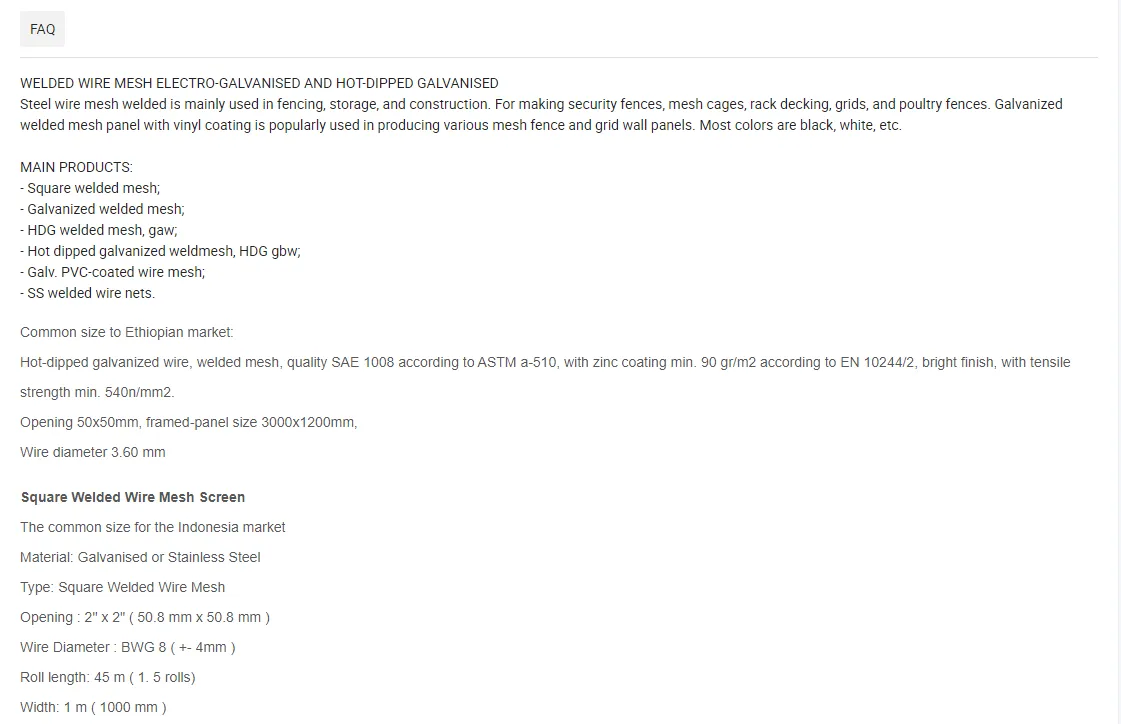Understanding Steel Grating Thickness Importance and Applications
Steel grating is a vital component in various industries, offering a combination of strength, durability, and versatility. One of the critical factors in selecting the right steel grating for a specific application is its thickness. The thickness of steel grating significantly influences its load-bearing capabilities, durability, and suitability for different environments.
What is Steel Grating?
Steel grating is a framework of welded or press-locked steel bars that create a grid-like structure. Commonly used in platforms, walkways, and industrial flooring, it allows for water drainage and light penetration while providing a sturdy surface for foot traffic and machinery. The design of steel grating includes various configurations of bars, spaces, and thicknesses, making it adaptable for a wide range of applications.
The Importance of Thickness
The thickness of steel grating affects its overall performance and suitability for different uses. Thicker gratings tend to offer higher load capacities, making them ideal for areas with heavy foot traffic or industrial equipment. Conversely, thinner gratings may be sufficient for pedestrian walkways or areas that experience less stress.
steel grating thickness

1. Load-bearing Capacity One of the most critical factors to consider when selecting the thickness of steel grating is its load-bearing capacity. Thicker grating can support more weight, which is essential in industrial settings where heavy machinery may be in use. For example, a thicker grating may be required in environments such as warehouses, factories, or construction sites where significant loads are common.
2. Durability The thickness of the steel also plays a crucial role in the durability and longevity of the grating. Thicker steel is typically more resistant to wear and tear, corrosion, and impact, making it suitable for harsh environments. In outdoor settings or areas exposed to chemicals, thicker gratings may provide extended service life compared to their thinner counterparts.
3. Safety In addition to load capacity and durability, the thickness of steel grating can contribute to safety. Thicker grating with a non-slip surface can reduce the risk of accidents in high-traffic areas. This is especially important in workplaces where safety regulations must be adhered to strictly.
4. Cost Considerations While thicker steel grating tends to offer enhanced performance, it often comes at a higher cost. Organizations must balance the need for durability and load capacity with budget constraints. For less demanding applications, it may be more economical to opt for thinner grating without compromising safety.
Conclusion
In summary, selecting the right thickness of steel grating is vital for ensuring optimal performance and safety in various applications. Thicker gratings provide superior load-bearing capabilities and durability, making them ideal for high-stress environments. However, considerations regarding cost and specific application needs also play a crucial role in decision-making. Ultimately, understanding the implications of steel grating thickness can lead to better choices in material selection, enhancing both functionality and safety in industrial and commercial settings.
-
The Best Metal Mesh Solutions: Expanded Aluminum Metal vs. Expanded Stainless Steel Metal
NewsSep.10,2024
-
Round Perforated Sheets vs. Hexagonal Perforated Sheets vs. Embossed Perforated Sheet Metal
NewsSep.10,2024
-
Perforated Metal Sheets
NewsSep.10,2024
-
Experience The Excellence Of Stainless Steel Grating
NewsSep.10,2024
-
Discover the Versatility Of Metal Mesh Expanded Forming Machines
NewsSep.10,2024
-
Discover The Advantages Of Steel Grating For Sale
NewsSep.10,2024
Subscribe now!
Stay up to date with the latest on Fry Steeland industry news.

